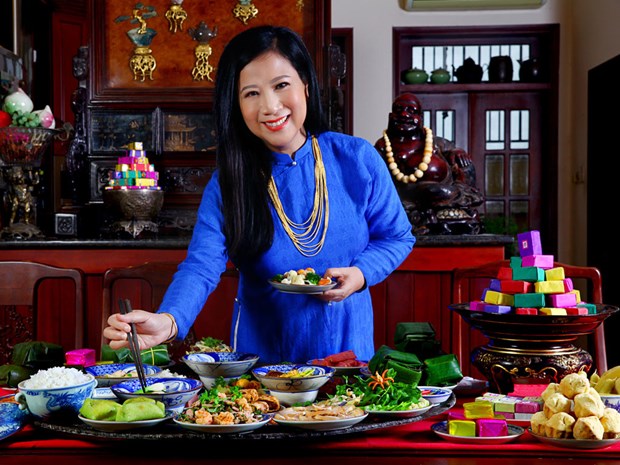People in Hue city prepared hundreds of dishes for Tet holiday, and how they preserved all of them from before Tet until 15 days later was a piece of art.
Viet
Nam shaped as an S from North to South, and the central got both influences of
the North and the South, which was clearly showed in their culinary culture.
Hue city is a cradle of culinary arts since it once was the capital of Viet
Nam, where both royal and common cuisine had thrived.

A meal slaver made by royal culinary artisan Ho Thi Hoang Anh – Photo: Hoang Thuy
The mixture of royal
culinary and common cuisine
People
in Hue city prepared hundreds of dishes for Tet holiday, and how they preserved
all of them from before Tet until 15 days later was a piece of art.
A
meal slaver divided into several types of food, such as main course (pork in
fish sauce, fermented grounded pork, gelatin pork, fried rolls, stewed pork
with duck eggs, boiled pork and sour shrimps), soups (stewed pork legs with
dried bamboo shoot), salads (fig, bamboo shoots, young jack fruit), and side
dishes (stir-fried bamboo shoot, stir-fried bean sprout).
Most
of the dishes were meticulously and carefully made as a latent competition of
talented housewives. One example was how to make Hue sour pork: they chose
fresh hot pork shank and chopped it without cold water cleaning; they added a
bit salt, well kneaded then mix thinly sliced skin in with roasted rice powder,
cooked fish sauce, garlic, sugar; the dough would be hand-shaped into small
balls, squeezed, then wrapped by Dong leaves and banana leaves; the leaf packs
would be hung from 2 – 3 days until ready to eat.
Tet
and other traditional holidays in Hue have to have plenty of sweets and sugared
fruits. Properly any produce could turn into sweets as oranges, kumquat,
ginger, lotus seeds, or even squashes.
The
most featured item of Hue was sugared ginger. In that city, ginger were grown
up on hills so ginger roots were small and dark yellow. People chose all young
roots, shaved off skin then skived. They boiled ginger twice or triple, drained
water off, sugared them then cooked on charcoal. The aromatic yet pungent
flavor made Hue sugared ginger so remarkable.
On
the other hand, cookies and dried sweets were also diverse in ingredients and
shapes, from hieroglyphs to flowers. The most popular is many small cakes put
together in pyramid shapes. All were to place on altars for ancestors.
According
to culinary artisan Ho Thi Hoang Anh, who is known as an ambassador of
Vietnamese cuisine at international culinary conferences, traditional meal
slavers are different from each region but basically, they always have rice and
sweet rice (Bánh-chưng and Bánh-tét which symbolized the ground and the sky as
ancestors’ belief).
In
the central of Viet Nam, Tet sweet-rice cake (Bánh-chưng and Bánh-tét) always
go with pickled sun-dried vegetables like pineapples, daikon, papaya, carrots,
and chili. The side dish has to be done weeks before Tet for dried vegetables
absorbing fish sauce and swelling. The absorbed salty dried vegetables do
enrich the taste of Bánh-chưng and Bánh-tét.
Furthermore,
Buddhist families usually prepare a vegetarian slaver in the very first day of
Lunar New Year for the ancestors. Just from common ingredients, such as banana
flowers, straw mushroom, peanuts, and tofu, Hue talented housewives can cook
plenty of delicious and eye-catching dishes.
Another
special type of Hue cuisine is fermented food, both vegetarian and
non-vegetarian food. Indeed, fermented food is good for digestive system and
they can be preserved for a long time.
Talking
about culinary culture in Tet meal slavers, Mr. Nguyen Dac Xuan – researcher
about Hue, member of Advocacy Committee to establish Vietnamese Culinary
Culture Association, said, “We might say
that Hue cuisine is a combination of royal and rural cuisine. That’s why Hue
food is so diverse. Nowadays, we still can see the imprint of royal cuisine in
daily meals, especially on meal slavers, through dainty decoration and delicate
decorative dishes and small bowls.”
Careful and
meticulous
Hue
people display their meal slaver as they decorate a piece of fine art. For
examples, let’s take a look of a dish of vegetables, which has white sliced
banana round outermost, a round of crescent-shape sliced figs, a round of
sliced fresh yellow star fruits, a pinch of herb above, and some slices of red
chili on top.
A
small dish is painted with many colors (white, pink, yellow, green, and red)
and many shapes (sun, crescent, stars, and clouds).
Taste
and appearance are not enough; food needs to be nutritious, too. Researchers
have claimed that Hue cuisine carries scientific and modern characteristics.
Basing on relentless practices for lives, Hue cuisine had gone through a
selecting process and what could last obviously became elite cuisine. For
examples, let’s look at a daily meal and see: if there is boiled pork, sour
shrimps and side vegetables have to come along.
Sour
shrimps are made from fresh water prawns, which are still alive and crackling.
They soak cleaned shrimps in rice wine, fish sauce, galangal, and sugar then
cover and placed under sunlight about 5 days. The fatty pork, sour shrimps, and
the acrid young banana or figs all combine into a flavorful bite. The meal is
not only tasty but also healthy in a scientific way.
The
carefulness, meticulousness, and delicacy in how Hue people cook and display
Tet meal slavers clearly reflect their royal customs and folk, even in each
common family.
By My Hanh/ Thanh Nien